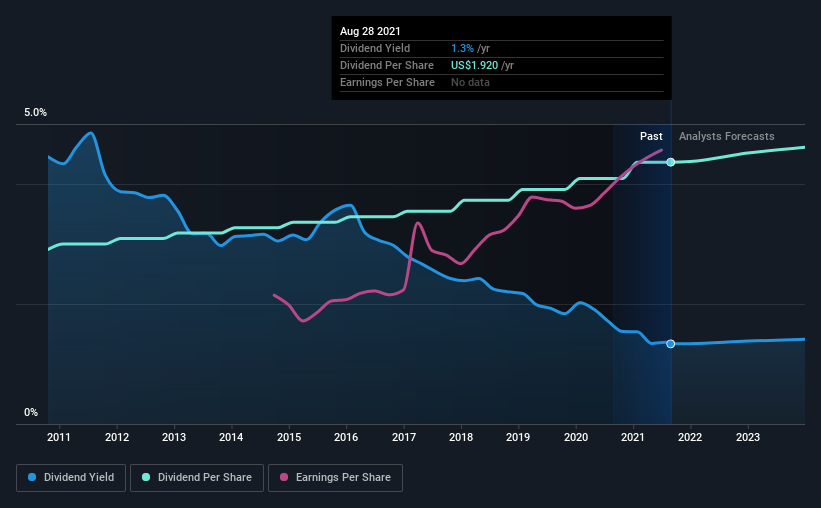Arthur J. Gallagher & Co. (NYSE:AJG) Looks Interesting, And It's About To Pay A Dividend
Regular readers will know that we love our dividends at Simply Wall St, which is why it's exciting to see Arthur J. Gallagher & Co. (NYSE:AJG) is about to trade ex-dividend in the next three days. Typically, the ex-dividend date is one business day before the record date which is the date on which a company determines the shareholders eligible to receive a dividend. The ex-dividend date is important as the process of settlement involves two full business days. So if you miss that date, you would not show up on the company's books on the record date. In other words, investors can purchase Arthur J. Gallagher's shares before the 2nd of September in order to be eligible for the dividend, which will be paid on the 17th of September.
The company's next dividend payment will be US$0.48 per share, on the back of last year when the company paid a total of US$1.92 to shareholders. Looking at the last 12 months of distributions, Arthur J. Gallagher has a trailing yield of approximately 1.3% on its current stock price of $143.76. If you buy this business for its dividend, you should have an idea of whether Arthur J. Gallagher's dividend is reliable and sustainable. So we need to investigate whether Arthur J. Gallagher can afford its dividend, and if the dividend could grow.
See our latest analysis for Arthur J. Gallagher
Dividends are typically paid from company earnings. If a company pays more in dividends than it earned in profit, then the dividend could be unsustainable. Arthur J. Gallagher paid out a comfortable 41% of its profit last year.
Generally speaking, the lower a company's payout ratios, the more resilient its dividend usually is.
Click here to see the company's payout ratio, plus analyst estimates of its future dividends.
Have Earnings And Dividends Been Growing?
Businesses with strong growth prospects usually make the best dividend payers, because it's easier to grow dividends when earnings per share are improving. If earnings decline and the company is forced to cut its dividend, investors could watch the value of their investment go up in smoke. Fortunately for readers, Arthur J. Gallagher's earnings per share have been growing at 17% a year for the past five years.
Arthur J. Gallagher also issued more than 5% of its market cap in new stock during the past year, which we feel is likely to hurt its dividend prospects in the long run. Trying to grow the dividend while issuing large amounts of new shares reminds us of the ancient Greek tale of Sisyphus - perpetually pushing a boulder uphill.
Many investors will assess a company's dividend performance by evaluating how much the dividend payments have changed over time. Arthur J. Gallagher has delivered an average of 4.1% per year annual increase in its dividend, based on the past 10 years of dividend payments. It's good to see both earnings and the dividend have improved - although the former has been rising much quicker than the latter, possibly due to the company reinvesting more of its profits in growth.
Final Takeaway
Has Arthur J. Gallagher got what it takes to maintain its dividend payments? Companies like Arthur J. Gallagher that are growing rapidly and paying out a low fraction of earnings, are usually reinvesting heavily in their business. Perhaps even more importantly - this can sometimes signal management is focused on the long term future of the business. In summary, Arthur J. Gallagher appears to have some promise as a dividend stock, and we'd suggest taking a closer look at it.
In light of that, while Arthur J. Gallagher has an appealing dividend, it's worth knowing the risks involved with this stock. For example, we've found 3 warning signs for Arthur J. Gallagher that we recommend you consider before investing in the business.
A common investment mistake is buying the first interesting stock you see. Here you can find a list of promising dividend stocks with a greater than 2% yield and an upcoming dividend.
This article by Simply Wall St is general in nature. We provide commentary based on historical data and analyst forecasts only using an unbiased methodology and our articles are not intended to be financial advice. It does not constitute a recommendation to buy or sell any stock, and does not take account of your objectives, or your financial situation. We aim to bring you long-term focused analysis driven by fundamental data. Note that our analysis may not factor in the latest price-sensitive company announcements or qualitative material. Simply Wall St has no position in any stocks mentioned.
Have feedback on this article? Concerned about the content? Get in touch with us directly. Alternatively, email editorial-team (at) simplywallst.com.

 Yahoo Movies
Yahoo Movies 

